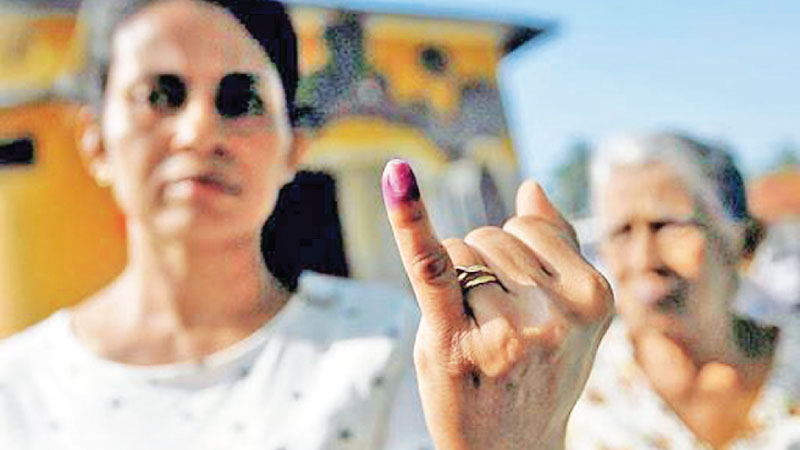With elections happening next month in the country and the nation preparing to elect candidates to Parliament, many experts pointed out the dire need to have more political representation from women at several International Women’s Day (IWD, March 8) events held in Colombo and other cities.
Here we take a look back at the struggle for women’s right to vote and participate in politics. The journey has not been easy, especially for women who fought for voting rights and political rights. The right to vote was a long struggle.
The present generation of women has the privilege of voting and voicing their political opinion. But this was always not the case. Many countries denied women the right to vote, leave alone enter Parliament and other political bodies.
Universal suffrage for women
The Women’s Suffrage Movement actually began in 1848, when a women’s rights convention was held in Seneca Falls, New York. The Seneca Falls Meeting was not the first in support of women’s rights, but suffragists later viewed it as the meeting that launched the Suffrage Movement. For the next 50 years, woman suffrage supporters worked to educate the public about the validity of woman suffrage. Under the leadership of Susan B. Anthony, Elizabeth Cady Stanton, and other women’s rights pioneers, suffragists circulated petitions and lobbied Congress to pass a Constitutional amendment to enfranchise women. At the turn of the century, the Women’s Suffrage Movement became a mass movement.
Some women in the Isle of Man (geographically part of the British Isles, but not part of the United Kingdom) gained the right to vote in 1881. New Zealand was the first self-governing country in the world in which all women had the right to vote in, but not to stand for, Parliamentary elections in 1893. Today they have a female Prime Minister.
The colony of South Australia allowed women of European descent to vote and stand for election in 1894 (although Australian Aboriginal women did not obtain universal suffrage until 1962). In Sweden, conditional women’s suffrage was granted during the age of liberty between 1718 and 1772. The Australian Commonwealth Franchise Act of 1902 enabled women to vote at federal elections and also permitted women to stand for election to the Australian Parliament, making the newly-federated country of Australia the first in the modern world to do so.
In 1906, the autonomous Grand Duchy of Finland, later the Republic of Finland, became the second country in the world to implement both the right to vote and the right to run for office. Finland was also the first country in Europe to give women the right to vote. The world’s first female Members of Parliament were elected in Finland the following year.
In Europe, the last jurisdiction to grant women the right to vote was the Swiss canton of Appenzell Innerrhoden (AI), in 1991; AI is the smallest Swiss canton with just 14,100 inhabitants (1990 statistics). Women in Switzerland obtained the right to vote at the federal level in 1986, and at a local cantonal level between 1959 and 1972, except for Appenzell in 1989/1990. In Saudi Arabia, women were first allowed to vote in December 2015 in the municipal elections.
In India, once it obtained the republic status in 1947, the nation gave its women the right to vote. Sri Lanka gave women the right to vote from 1931. China first granted the right for women to vote in 1947.
Women in Canada could vote beginning in 1916. Suffrage expanded to the federal level over the next few years: In 1917, nurses and women in the Armed Forces could vote, and also women whose fathers, husbands or sons were serving overseas. In 1918, legislation was passed expanding suffrage to female citizens excluding Asian-Canadian women and First Nation women, who did not win the right to vote until the 1940s and 1960, respectively.
Lankan women in politics
Since 1931, women have served successfully in Parliament. The first woman representative was Adeline Molamure who was elected to the State Council. She was the daughter of J.H. Meedeniya and wife of Alfred Francis Molamure, both State Councillors.
Sixty women have served in the legislature of Sri Lanka, including 13 who are currently serving, constituting five percent of current members. Women in Parliament, however small in numbers, have held high positions in Parliament and the Cabinet. Two women became Prime Ministers and one has gone on to become the President of Sri Lanka. Sirimavo Bandaranaike became the world’s first female head of government on July 21, 1960, and held the post for a non-consecutive 17 years. Her daughter, Chandrika Bandaranaike Kumaratunga, became Sri Lanka’s first modern female Head of State and President.
The progress of women in Sri Lankan politics, however, has stagnated as expectations are higher for their representation in Parliament. Women constitute 52 percent of Sri Lanka’s population and more than 50 percent of the registered voters are female. Against this backdrop, it is quite ironic that the country has failed to engage more women in politics. It is uncertain as to what exactly causes the majority of women to stay as far away as possible from actively taking part in politics.
In June 2017, Sri Lanka was ranked 180th out of 190 countries in the Inter-Parliamentary Union (IPU) ranking of female representation in Parliament. Women’s involvement in local politics in Sri Lanka has been one of the lowest in South Asia. Only four percent of the seats in Provincial Councils and 1.9 percent in Local Government bodies have been held by women until 2012. However, efforts are underway to increase this figure to 25 percent.



Add new comment